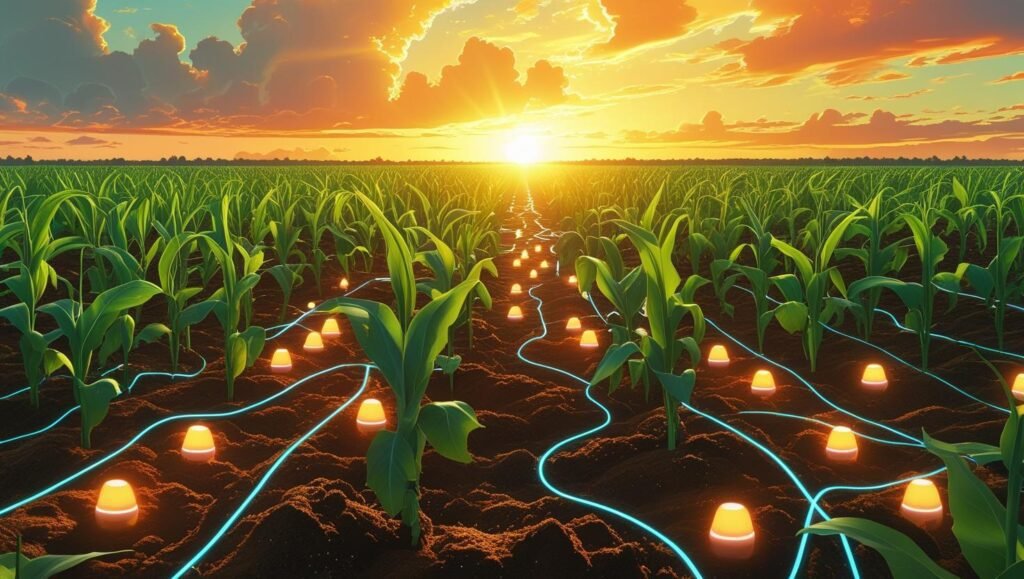Why IoT Sensors Are Farming’s Future Now

Farming has always been hard work, but it’s changing fast. Thanks to smart agriculture, farmers can grow more food with less stress. Imagine a farm where sensors tell you exactly when crops need water or warn you about pests before they strike. That’s what Internet of Things (IoT) sensors do, and they’re making farming easier and smarter. In this post, we’ll explore why IoT sensors are the future of farming and how they solve real problems for farmers today.
What Are IoT Sensors in Smart Agriculture?
IoT sensors are tiny devices that collect data from farms. They measure things like soil moisture, temperature, or even how healthy plants are. This data helps farmers make better decisions. For example, instead of guessing when to water crops, a sensor tells you exactly when it’s needed.
These sensors connect to the internet, so farmers can check the data on their phones or computers. It’s like having a super-smart assistant watching over your farm 24/7. With smart agriculture, IoT sensors save time, cut costs, and boost crop yields.
How Do IoT Sensors Work?
IoT sensors are placed in fields, greenhouses, or even on livestock. They gather information and send it to a central system. Farmers can see this data in real-time, which means they can act fast if something’s wrong.
- Soil sensors: Check moisture and nutrients to avoid overwatering or underfeeding crops.
- Weather sensors: Track temperature and humidity to protect plants from extreme conditions.
- Livestock sensors: Monitor animal health, like heart rate or movement, to catch problems early.
Why IoT Sensors Are a Game-Changer for Farmers
Farming is full of challenges—unpredictable weather, pests, and rising costs. IoT sensors tackle these problems head-on. They give farmers the tools to work smarter, not harder. Let’s look at the biggest benefits of using IoT sensors in smart agriculture.
Save Water and Resources
Water is precious, but many farms waste it by overwatering. IoT sensors measure soil moisture and only water crops when needed. This saves water, lowers bills, and helps the environment. Some farmers have cut water use by up to 30% with these sensors!
Boost Crop Yields
Healthy crops mean more food and more money. IoT sensors spot problems early, like low nutrients or pests. By fixing issues fast, farmers can grow stronger plants. Studies show smart agriculture tools can increase yields by 20% or more.
Work Less, Earn More
Farming is time-consuming, but IoT sensors do the heavy lifting. They monitor crops and animals around the clock, so farmers don’t have to. This means less stress and more time for other tasks. Plus, higher yields and lower costs mean bigger profits.

Real-Life Examples of IoT in Farming
IoT sensors aren’t just a future dream—they’re working on farms right now. For example, a tomato farmer in California used soil sensors to cut water use by 25%. In India, a dairy farmer used livestock sensors to catch sick cows early, saving thousands in vet bills.
These stories show how smart agriculture is changing lives. Farmers don’t need to be tech experts to use IoT sensors. Many systems are simple to set up and easy to understand, even for beginners.
Challenges to Overcome
IoT sensors are amazing, but they’re not perfect. Some farmers worry about the cost of buying and installing them. Others live in areas with poor internet, which can make sensors less effective. However, new technology is making sensors cheaper and more reliable every year.
Want to know how farmers are solving these challenges? There’s exciting research happening, but we’ll get to that in a moment.
How IoT Sensors Fit Into the Future of Farming
As the world’s population grows, we need more food than ever. Smart agriculture with IoT sensors is the answer. These tools help farmers grow more with less land, water, and energy. They also make farming more sustainable, which is good for the planet.
In the future, IoT sensors could team up with drones and robots to create fully automated farms. Imagine a farm where sensors, drones, and machines work together to plant, water, and harvest crops. It’s not science fiction—it’s already starting!
Why You Should Care About Smart Agriculture
Whether you’re a farmer or just someone who eats food, IoT sensors matter. They help grow more food, keep prices low, and protect the environment. By supporting smart agriculture, we’re building a better future for everyone.
Conclusion: The Future Is Here, But There’s More to Learn
IoT sensors are transforming farming, making it smarter, easier, and more sustainable. From saving water to boosting yields, these tools solve real problems for farmers. Smart agriculture is the future, and it’s happening now. But there’s so much more to discover about how these sensors work and what’s next.
Curious to dive deeper? There’s a fascinating research paper that explores the latest IoT breakthroughs and how they’re shaping farming. Click the button below to read it and learn what’s coming next for smart agriculture!
Read the Research Paper




